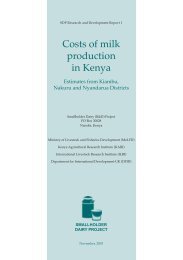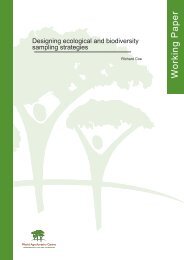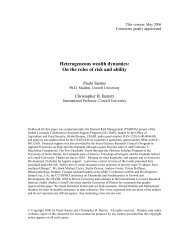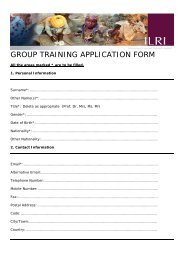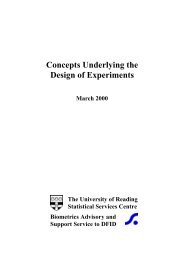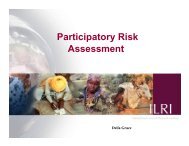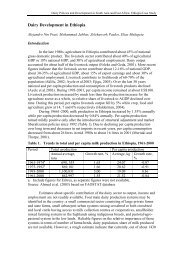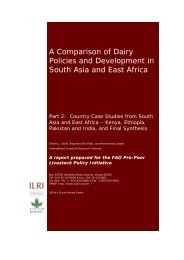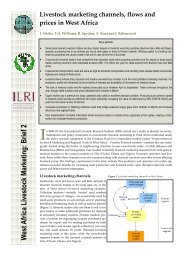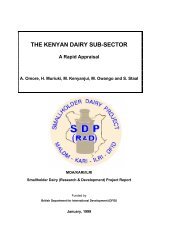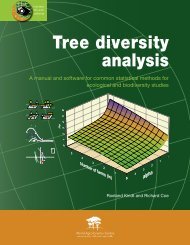well <strong>in</strong>tegrated <strong>in</strong>to the farm<strong>in</strong>g systems. In the more sub-tropical and tropical regions <strong>of</strong> Ch<strong>in</strong>a, buffaloesand cattle are used widely to supply draft power for cultivation and haulage and milk. Currently, not enoughis known about the methodologies used for <strong>in</strong>tegration <strong>in</strong> these mixed farm systems, the rationale for us<strong>in</strong>gone or more <strong>of</strong> the chosen species, the role <strong>of</strong> <strong>in</strong>digenous knowledge and, more particularly, the effects <strong>of</strong>their <strong>in</strong>teractions <strong>in</strong> economic and environmental terms. A better understand<strong>in</strong>g <strong>of</strong> these <strong>in</strong>tegrated systemsand potential improvements to them through strategic research will be valuable <strong>in</strong> the development <strong>of</strong> moresusta<strong>in</strong>able production systems, which will have relevance to other countries <strong>in</strong> the region.Feed resourcesThe available feed resources are diverse and <strong>in</strong>clude grasslands (native and sown), crop residues, AIBP andNCFR. Inventories <strong>of</strong> these feeds <strong>in</strong> terms <strong>of</strong> the availability, quality and seasonality <strong>of</strong> production have notbeen undertaken systematically. The use <strong>of</strong> gra<strong>in</strong> to feed pigs and poultry is a major issue, s<strong>in</strong>ce surplusesfrom with<strong>in</strong> Ch<strong>in</strong>a are presently <strong>in</strong>adequate to meet animal requirements, with the result that the country isnow a net importer <strong>of</strong> gra<strong>in</strong>s. Currently, strategies are be<strong>in</strong>g aimed at reduc<strong>in</strong>g imports and the costs <strong>of</strong> animalproduction. For pigs and poultry, an important challenge is to f<strong>in</strong>d locally produced substitutes for gra<strong>in</strong> <strong>in</strong>the diet <strong>of</strong> these species.To address the critical issue <strong>of</strong> feeds, the Institute <strong>of</strong> <strong>Animal</strong> Science <strong>in</strong> CAAS has <strong>in</strong>itiated a majorproject with<strong>in</strong> the N<strong>in</strong>th Development Plan (1996–2000) to <strong>in</strong>vestigate the present status and potential <strong>of</strong>feed resources for herbivore animals <strong>in</strong> cropp<strong>in</strong>g areas <strong>in</strong> Ch<strong>in</strong>a. The work will be undertaken <strong>in</strong> five prov<strong>in</strong>ces<strong>in</strong> central Ch<strong>in</strong>a (Anhui, Hebei, Henan, Shangdong and Shanxi), and six prov<strong>in</strong>ces <strong>in</strong> South Ch<strong>in</strong>a (Fujian,Guangxi, Guangdong, Guizhou, Hunan and Yunnan).Hunan Prov<strong>in</strong>ceHunan Prov<strong>in</strong>ce <strong>in</strong> southern Ch<strong>in</strong>a lies between latitudes 25 and 30° North. The climate is sub-tropicalmonsoonal, with an annual ra<strong>in</strong>fall <strong>of</strong> 1400–1600 mm. The average annual temperature is 16°C and 270 daysare frost-free. The climatic conditions are good for a wide range <strong>of</strong> crops. Soils are generally deficient <strong>in</strong>nitrogen, and 70–80% are deficient <strong>in</strong> phosphorus. Other deficiencies <strong>in</strong>clude potassium, boron and z<strong>in</strong>c. Theprov<strong>in</strong>ce covers an area <strong>of</strong> 211,800 km 2 and has a human population <strong>of</strong> 64 million. There are 15 millionhouseholds farm<strong>in</strong>g 7.3 million ha <strong>of</strong> cropland, <strong>of</strong> which 0.8 million ha are <strong>in</strong> the uplands (non-paddy rice<strong>in</strong> areas with >15% slope). Over 6.0 million ha <strong>of</strong> forest and over 2.0 million ha <strong>of</strong> native grasslands occurma<strong>in</strong>ly <strong>in</strong> the uplands. Average farm size varies but is generally under 1.0 ha.Rice is the most important crop <strong>in</strong> the prov<strong>in</strong>ce cover<strong>in</strong>g about 4.1 million ha. Early-season rice covers2.6 million ha, late-season rice (ma<strong>in</strong>ly hybrids) covers 0.9 million ha, and s<strong>in</strong>gle-season rice (ma<strong>in</strong>lytraditional varieties) covers about 0.6 million ha. More than 70% <strong>of</strong> early- and late-season rice is grown underirrigation. Early season rice is sown at the end <strong>of</strong> March and harvested at the beg<strong>in</strong>n<strong>in</strong>g <strong>of</strong> July. Late-seasonrice is sown <strong>in</strong> early July and harvested <strong>in</strong> mid-August. Hybrid rice development is a special achievement <strong>of</strong>the prov<strong>in</strong>cial academy <strong>of</strong> agricultural sciences. Other crops <strong>of</strong> importance <strong>in</strong>clude wheat, barley, oil–rape,maize, vetch (for green manure) and vegetables. Typical cropp<strong>in</strong>g patterns <strong>in</strong>clude early rice/vetch–late rice;rice/oil–rape; early rice–late rice–wheat; maize–rice; rice–watermelon and chili–rice. In the uplands,soyabean, sweet potato, potato, cotton and maize are also produced. Both organic and <strong>in</strong>organic fertilisersare applied to crops.Mixed farm<strong>in</strong>g systems are extremely important <strong>in</strong> the prov<strong>in</strong>ce, and more than 90% <strong>of</strong> the farmerskeep animals. Pigs are the most important species and the prov<strong>in</strong>ce is the major producer <strong>of</strong> pork <strong>in</strong> Ch<strong>in</strong>a.Poultry (chicken, ducks and geese) are the second most important farm animals followed by cattle and goats.Cattle and buffaloes are kept for draft power, manure, and milk production. Goats are valued for meat,although the production <strong>of</strong> hides from the Black goat (probably orig<strong>in</strong>at<strong>in</strong>g from the Black Bengal breed <strong>of</strong>India), whilst important, is not be<strong>in</strong>g exploited commercially. In the lowland rice-grow<strong>in</strong>g areasnon-rum<strong>in</strong>ants predom<strong>in</strong>ate whilst, <strong>in</strong> the uplands, cattle and goats are more common.In 1996, 90 million pigs, 558 million poultry, 6.8 million cattle and buffaloes, and 8.1 million goatswere produced, <strong>of</strong> which 59, 57, 24 and 44%, respectively, were sold, <strong>in</strong>dicat<strong>in</strong>g a fairly high <strong>of</strong>f-take. Some,41% <strong>of</strong> the value <strong>of</strong> the agricultural output <strong>in</strong> the prov<strong>in</strong>ce came from animals, and 70–80% <strong>of</strong> the value <strong>of</strong>
the animal output came from pigs alone. <strong>Animal</strong>s provide about 60% <strong>of</strong> the cash <strong>in</strong>come <strong>in</strong> smallholder mixedfarms. The prov<strong>in</strong>ce has surplus gra<strong>in</strong> and animal products, which are exported to other prov<strong>in</strong>ces. In 1996,20 million pigs were transported to other prov<strong>in</strong>ces.<strong>Crop</strong> residues and AIBP are pr<strong>in</strong>cipal feeds for animals. The native grasslands <strong>in</strong> the uplands are utilisedby rum<strong>in</strong>ants, which also graze lowland rice-stubble after harvest. Graz<strong>in</strong>g is controlled by herders, but mixedgraz<strong>in</strong>g <strong>of</strong> animal species is not common. Other rum<strong>in</strong>ant feeds <strong>in</strong>clude rice straw and sweet potato v<strong>in</strong>es andtubers. Silage is made from ammoniated rice straw and vegetable residues. Currently, about 1.33 milliontonnes <strong>of</strong> rice are consumed by pigs, which is <strong>in</strong> direct competition with human gra<strong>in</strong> requirements. As part<strong>of</strong> the national approach, efforts are be<strong>in</strong>g made to reduce the feed<strong>in</strong>g <strong>of</strong> gra<strong>in</strong>s to animals through <strong>in</strong>creasedutilisation <strong>of</strong> crop residues and AIBP.Follow<strong>in</strong>g the economic reform, more farmers have become <strong>in</strong>terested <strong>in</strong> animals (poultry, pigs andgoats) to generate cash <strong>in</strong>come. Medium to large farms have adopted <strong>in</strong>tensive or specialised animalproduction systems, and are produc<strong>in</strong>g gra<strong>in</strong> for both human and animal consumption as well as us<strong>in</strong>g cropresidues and AIBP.In order to develop animal production to meet the rapidly <strong>in</strong>creas<strong>in</strong>g demand for animal prote<strong>in</strong>, theprov<strong>in</strong>cial government has established 51 production bases (stock farms with tra<strong>in</strong><strong>in</strong>g and <strong>in</strong>formationfacilities for farmers) for pigs, 18 for cattle, 15 for poultry and five for goats. These bases l<strong>in</strong>k the research<strong>in</strong>stitutions, the m<strong>in</strong>istry, extension services and the feed and drugs companies with market opportunities.Women participate <strong>in</strong> almost all aspects <strong>of</strong> animal management, particularly <strong>in</strong> non-rum<strong>in</strong>ant systems.However, few women pr<strong>of</strong>essional scientists and extension workers are engaged <strong>in</strong> animal production.In order to produce more and better-quality products for a market with consumers <strong>of</strong> <strong>in</strong>creas<strong>in</strong>g <strong>in</strong>come,the follow<strong>in</strong>g strategies have been developed:• Preparation <strong>of</strong> formula feeds us<strong>in</strong>g a mixture <strong>of</strong> local resources.• Ammoniation and use <strong>of</strong> microbes to treat straws.• Use <strong>of</strong> artificial <strong>in</strong>sem<strong>in</strong>ation for cattle and pigs.• <strong>Improvement</strong> <strong>of</strong> animal hous<strong>in</strong>g and management to reduce diseases.• Cycl<strong>in</strong>g <strong>of</strong> manure.• Development <strong>of</strong> extension services and the provision <strong>of</strong> management guidance to farmers throughassociations such as those for pig and goat farmers.• Tax relief to encourage <strong>in</strong>tensive and <strong>in</strong>tegrated mixed farm<strong>in</strong>g.In the north <strong>of</strong> Ch<strong>in</strong>a, triticale is <strong>in</strong>creas<strong>in</strong>g <strong>in</strong> importance as a pre-rice silage crop for rum<strong>in</strong>ants. Thecultivars developed have not been tested <strong>in</strong> Hunan Prov<strong>in</strong>ce, and research workers seemed unaware <strong>of</strong> thiswork. There is no reason why triticale could not be grown <strong>in</strong> Hunan Prov<strong>in</strong>ce as a silage crop for small farmerswho are already used to mak<strong>in</strong>g silage.S<strong>in</strong>ce 1989, a major effort has been made to expand research and development activities with Blackgoats. It is anticipated that, <strong>in</strong> the future, goat meat consumption will <strong>in</strong>crease whilst that <strong>of</strong> beef will decrease.By the year 2000, two million goats will be produced annually, account<strong>in</strong>g for 40% <strong>of</strong> the value <strong>of</strong> all animaloutput. Goat production is go<strong>in</strong>g to be expanded beyond the mixed farms to forest and mounta<strong>in</strong> areas, andexport to other prov<strong>in</strong>ces is anticipated. The reasons for this are:• Pig production cannot be <strong>in</strong>creased without divert<strong>in</strong>g gra<strong>in</strong> from human consumption. Also, the use <strong>of</strong>gra<strong>in</strong>s for feed<strong>in</strong>g pigs makes production less pr<strong>of</strong>itable and pork more expensive.• Goats can be produced at a much lower cost than pigs us<strong>in</strong>g local feed resources with m<strong>in</strong>imalsupplements.• The demand for goat meat has risen rapidly with <strong>in</strong>creased <strong>in</strong>come, particularly <strong>in</strong> the w<strong>in</strong>ter seasonwhen the price is highest.
- Page 2 and 3:
Affiliation of Authors:Dr C. Devend
- Page 4 and 5:
6.Strategyfor researchJustification
- Page 7 and 8:
AcknowledgementsThe International L
- Page 9 and 10:
esearch opportunities appropriate t
- Page 11 and 12:
Table 1.Animal populations and meat
- Page 13 and 14: Introduction2. Characterisation and
- Page 15 and 16: Figure 2. Sub-humid tropics and sub
- Page 17 and 18: Table 3.Human and animal population
- Page 19 and 20: Table 5. Rice-growing environments
- Page 21 and 22: Multiple upland annual crop systems
- Page 23 and 24: Table 6. Continued.Country Importan
- Page 25 and 26: It should be noted that, compared w
- Page 27 and 28: Table 8.CountryCambodiaChinaIndones
- Page 29 and 30: of non-renewable fossil fuels and t
- Page 31 and 32: Overview of researchThere was a sur
- Page 33 and 34: • Identification of alternative c
- Page 35 and 36: Various animal production systems t
- Page 37 and 38: Presently, much of the vegetable pr
- Page 39 and 40: Table 10. Summary of the main socio
- Page 41 and 42: Table 11. Institutions and organisa
- Page 43 and 44: 3. In the ASEAN sub-region, inadequ
- Page 45 and 46: Table 12. Continued.SituationsPract
- Page 47 and 48: 6. Strategy for researchJustificati
- Page 49 and 50: Table 13. Priorities for research a
- Page 51 and 52: VietnamResearch capacity in NARS is
- Page 53 and 54: CRIFC (Central Research Institute f
- Page 55 and 56: IAS. 1995. Proceedings of the Works
- Page 57 and 58: Systems of sub-Saharan Africa. Volu
- Page 59 and 60: or waterlogged in the wet season an
- Page 61 and 62: Table A1. Important diseases of ani
- Page 63: • Increased cropping intensities,
- Page 67 and 68: 18-21° North, with an average rain
- Page 69 and 70: In the Nusa Tenggara islands, signi
- Page 71 and 72: Women work 11.5 h/day on average co
- Page 73 and 74: Various Australian forage projects
- Page 75 and 76: village production systems; to stud
- Page 77 and 78: The availability of feed in rubber
- Page 79 and 80: of the Ayeyarwady and Sittang river
- Page 81 and 82: Constraints and opportunitiesInadeq
- Page 83 and 84: gaining in importance, and signific
- Page 85 and 86: Table A3. Characterisation of crop-
- Page 87 and 88: Table A4. Interventions in crop-ani
- Page 89 and 90: Table A4. Continued.Project TitleGo
- Page 91 and 92: otations are practised, and there a
- Page 93 and 94: such as abortion. Vaccination cover
- Page 95 and 96: large areas of forests (3.4 million
- Page 97 and 98: Table A6. Some animal diseases repo
- Page 99 and 100: Appendix IIItineraryThe Philippines
- Page 101 and 102: 26 November 1996 am Visit to small
- Page 103 and 104: Appendix IIIList of persons metPhil
- Page 105 and 106: Mr Chhiv Nan, Acting Director, Depa
- Page 107 and 108: Dr U Maung Ngint, Managing Director
- Page 109: List of acronymsAARDACIARADBAEZAIBP



